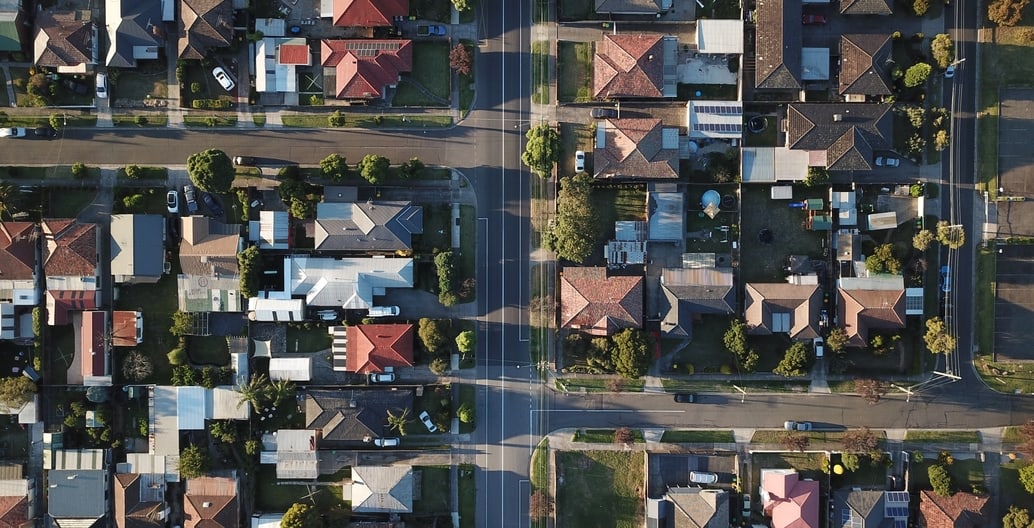
From placemaking to place survival: Experts and the new community activism
In the face of government inaction, communities are mobilising to develop their own plans to survive the threats of climate change. At a summit in Brisbane, built environment professionals shared how they are working to help their own community, and looking to empower others.
As fires threaten suburbs, smoke continues to blanket Sydney and health warnings are issued, the lack of government action is making headlines. Back in April, journalist and commentator George Monbiot warned that no one is coming to save us. Last month we heard that those threatened by early fires in Sydney “may not get help”. This week it was reiterated that “if there is no government help, there is just no help.” Meanwhile the Prime Minister was reported to flatly refuse help to volunteer firefighters as “they want to be there”.
A few weeks ago in Brisbane, a group comprising mainly built environment professionals, academics and local government officers met at the University of Queensland for the 2019 Placemaking Summit. The community empowerment of placemaking has always accepted that people who live in an area have intimate knowledge of and are effective experts in the conditions of their daily, lived place. Professionals of various disciplines have traditions of pro bono assistance and programs of corporate social responsibility. What role can designers play in enabling communities to take effective control of physical development and improvement in neighbourhoods? How can local communities grapple effectively with the challenges of global climate change?
Making necessary shifts
The summit was part of the Placemaking Sandbox Project, funded by the Myer Foundation. However, unlike many placemaking gatherings, the day was less about celebrating the rise and projects of everyday urbanism, although it has a background in building those same relationships, trust and resilience. It was more about the radical shifts that climate change is urging, and the unprecedented decisions and interventions that communities and practitioners will very soon need to make.
Both parts of the summit title – Shifting Climate / Shifting Places – have double references. They hint at not just a shift in global weather conditions but a change in the temperature of public opinion and political climate. And while we watch disturbing shifts in the conditions of physical places around us – such as burning of never-berfore-burnt rainforests – we are also seeing shifts in responsibility. Communities are stepping up in the face of unprecedented threats, taking the place of underfunded agencies or absent authorities.
Community empowerment and citizen-led action is nothing new. Booklists have been circulating in Australia since at least the federal election, revisiting old and newer reads for troubled times and organising grassroots change. Community activism is gaining in strength and cutting across boundaries of age, wealth and cultural background with a renewed sense of urgent common purpose. There is frank realisation of the shortfalls of ever-growing funding cuts to various community services and that losses occasioned by departmental restructuring will need to be addressed by more than struggling charities.
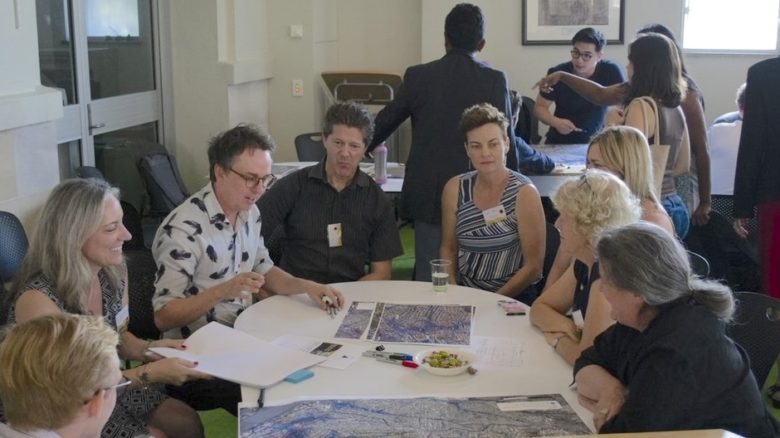
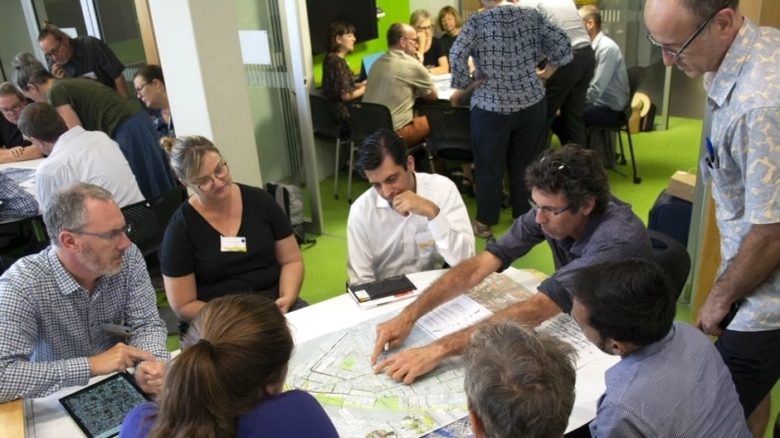
Built environment professionals, academics and local government officers at the 2019 Placemaking Summit at the University of Queensland.
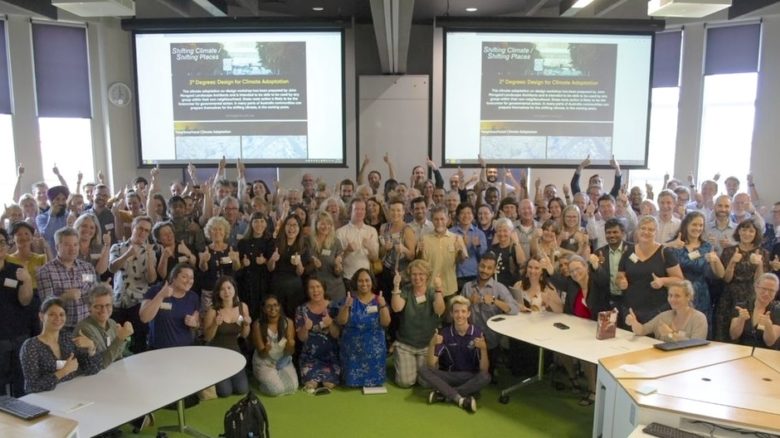
Running out of time
The open-source Climate Clock was launched yesterday showing our remaining global carbon budget and the time we have left for action that will keep us within it. While placemaking has always been about empowering communities to act for preferred development of their own environments, the threats of a changing global climate gives such empowerment new perspective and new impetus.
Key organisers of the summit content include landscape architect John Mongard, Bob Spiers who has a background in natural resource management, Pam Bourke who has expertise in community development and James Davidson of James Davidson Architect. The summit concluded with placemaking professionals Dominique Hes, Brooke Williams and Sebastien Darchen offering reflections on the day’s presentations, speeches and workshops.
Following a moving Welcome to Country by Aunty Ruby Sims, and introductory remarks that clearly linked placemaking and climate action, Halvard Dalheim delivered a keynote address in which he made important points about how planning and policy can better tackle climate change. With a minister, state government architect and local government officers present, Dalheim reminded all that it is “important to have not just experts in the room but leaders who will listen”.
Dalheim also suggested that we may need to develop plans and policy “where you can’t use the language you would like to.” To get things adopted that tackle climate change, it can be best not to actually use those terms “and that might not matter”. There is a Machiavellian realpolitik to such self-editing, but, again, it may be that events will overtake such courtier’s caution.
Dalheim’s suggestions do raise questions: does this approach simply take too long and should we be reinforcing a system that demands so much energy to navigate the approval of politicians? Such questions should not be mistaken for either environmental or industrial relations red-tape congestion-busting that would overlook input from qualified experts. Business recognises that their customers will reward good planning and bold vision, which shapes well-researched, anticipated change. Industrial unrest and the threats of climate change already guide insurance and investment decisions and government attempts to ban boycotts and expressions of popular will, do business no favors.
Dalheim has reviewed most Australian Capital City Plans and noted that there are lots of similarities in mitigation and adaptation approaches. But city plans are not state policy so they must garner state and, ideally, federal support. Having ‘legislative teeth’ is vital and the terminology of ‘must’ needs to be used for quantitative targets, rather than voluntary alignment with policy intention for quality. Environmental management is complex due to both the networks of environmental interdependencies and the networks of human values. We could learn from the fate of agri-environment policy: “It took off as a partnership, and sought to empower communities and regions. But it didn’t fix the things it was set up to fix, so, over the years, it progressively moved the emphasis from empowerment to targeted grants focused on specific environmental assets… We are much better placed to define and measure what we should be doing, but have lost sight of the suite of community capacities that enable those actions to be effectively undertaken.”
Using Western Sydney as an example – and touching curiously on social inequality with reference to Squinters and the tribes of those born on the right and wrong side of rivers and tracks – Dalheim listed opportunities to invest in a range of approaches to low-carbon development and a low-carbon economy. Such large, vision-shaping projects as the aerotopolis do, indeed, need collaboration and shared goals. So, not unlike community empowerment basics, they rely on building good relationships. “You need to ask other departments, councils, collaborators – how can I help you? – as well as asking people whether they can help you.” Dalheim confessed disingenuously that “when you’re at the top no-one rings,” adding a nod to the workers “but everyone calls the people at the coalface all the time.”
The people at the coalface
Following Dalheim’s keynote presentation, four morning presentations described the founding of a “neighbourhood framework for climate action” and the formation of a friendship between Bob Spiers, Pam Bourke and landscape architect John Mongard. Together they started the Kurilpa Climate Strategy with a view to building the capacities of their own community to prepare for climate change. Architect James Davidson, who had also been investigating flood responses since 2011, joined them.
Speirs spoke first. “I’m retired. Which is when you get to do what you want. With naps.” In reflecting on Aunty Ruby Sims’ Welcome to Country, Speirs remarked that “we are given the gift of story”. The enlightened empathy that comes with listening to the stories of others is a powerful capacity. Speirs explains that he finds himself whispering and listening even walking through the bush. But this isn’t about being a quiet Australian. After listening, there’s more. Invoking the mission of the Kurilpa Futures group, Speirs emphasises that as a community “We claim our voice. We claim our part in the action.”
In developing a strategy, the group has characterised three dynamic aspects of healthy communities: the capacity to reset expectations, regain knowledge, assets and control, and rebound from setbacks. This effectively describes resilience.
With a presentation that echoed the main theme of the day, social planner and community development expert Pam Bourke announced that “the cavalry isn’t coming.” Bourke is from Brisbane. She began her presentation by recounting a formative experience for her community immediately following the 2011 floods. “We set up a marquee at the end of the street, not sure what would happen,” recalls Bourke. “After a while people gradually turned up and then more and more came: people who just wanted to talk, people who wanted to help and people who needed help.”
By the time that relief services arrived, the community had already organised to help each other, sweeping and clearing out flooded homes, piling rubbish and generally supporting the clean-up process so that others were too late to be needed. That got Bourke thinking about the future and building on the ready good will she’d seen in action. How could her community strategically continue to adapt and be ready to mobilise for the impacts of climate change still to come?
The Kurilpa community includes significant new younger families and also vulnerable groups including the elderly. Thirty-two percent are lone-person households. The community needed data on gender, culture and Indigneous residents to include all perspectives in making a just transition for their neighbourhood. Outlined by the trade union movement and adopted by the IPCC and others in their strategies for climate change adaptation, a just transition considers the range of social interventions needed to secure workers’ rights and livelihoods when economies are shifting to sustainable production or environments are adapting to new conditions.
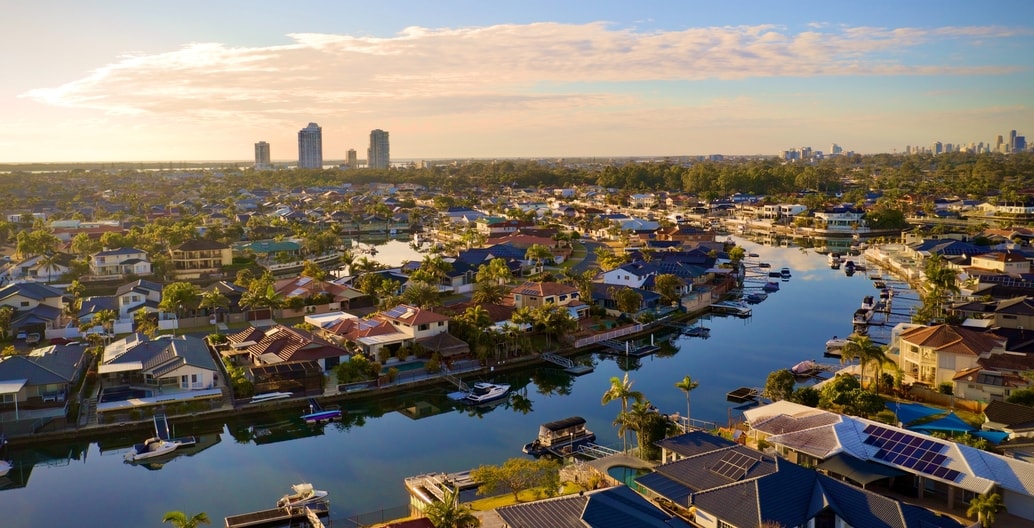
Community development in Queensland has a strong tradition and history beginning in the 1970’s. While the International Association for Community Development (IACD) defines community development as “a practice-based profession and an academic discipline” there is no unified approach. Bourke quoted Kelly and Westoby to explain the underpinning objective of moving private concerns to public action. It is also, for her, clearly about moving from outdated and politically ineffective DAD (Decide, Announce, Defend) approaches to governance, to LIEP (Listening, Informing, Enabling, Participation). She knows that people come from many different starting points and that finding collaborators and determining agreed action is itself empowering.
Bourke contacted John Mongard the week after he had determined to do something and their work led to the Kurilpa Climate Strategy, which is public, online and intended to be shared. Developing a more self-supporting neighbourhood environment is also about reducing impacts beyond the neighbourhood. Mongard is critical of continuing to build on arable land, particularly as current suburban subdivision delivers ever-smaller lots with no garden, while agriculture moves into desert landscapes that rely on artesian water.
There are examples of fighting this trend. Bingara is a small town that is looking to grow its own food by 2020, linking agriculture, tourism and education with community revitalisation. Even with older suburbs infill we could do better and preserve trees and biodiversity while increasing density such as Seattle is doing. There are various tactics for delivering an infiltration of landscape and agriculture into cities as they grow. Ecological and species secession is something permaculture speaks of in understanding how retrofitting and restoration of environmentally healthy landscapes might happen in natural stages.
“Design-led or disaster-led?” asked Mongard. A climate crisis is a place crisis and built environment professionals have important contributions to make right now. Reinforcing a driving theme of the day, Mongard urged us to appreciate that we don’t have much time. If we don’t start designing for a climate-changed future, disaster will change everything without us. “What would drive people to act?” He believes governments will not act in time and that it makes sense to target what we know and love: the places we live in and people we care about. “We need to give people tools to act,” he declared. Mongard has already reduced his practice to three days per week to leave time to commit to local projects adapting to climate change.
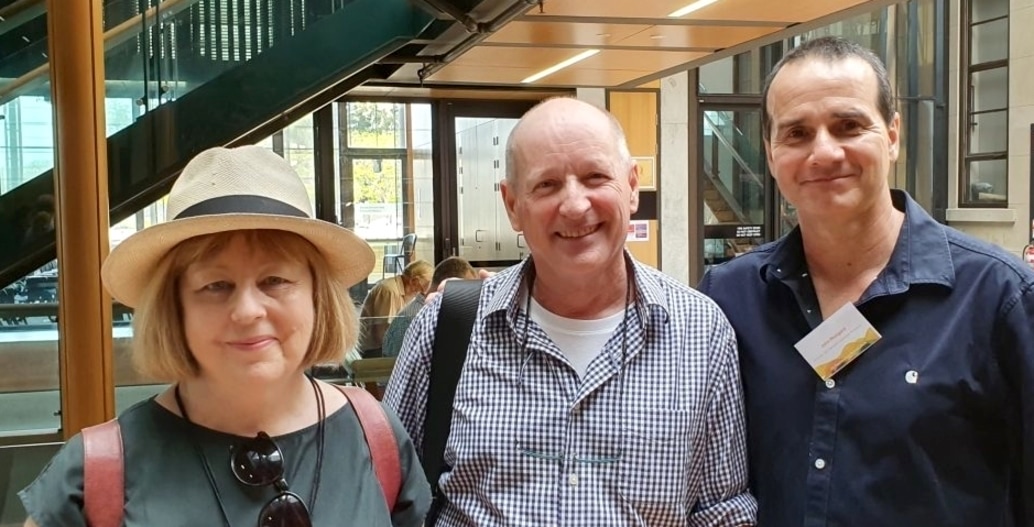
Speaking from Spain, James Davidson outlined some of the work his practice has done to respond to the lessons of the 2011 South East Queensland floods. Published in The Water Futures Book, five years of work from a range of expert contributors considers how architecture and design can begin to build deliberately with flood in mind. “We can’t stop flooding but we can mitigate impacts and minimize disruption by considering recovery processes,” explains Davidson. Material choice and house layout can make it possible for flood to come through and cause no structural or permanent building damage. Interestingly, the practice had managed to negotiate more favorable insurance premiums for clients rebuilding with these strategies.
Supported by a Churchill Fellowship Davidson examined responses to increased flooding and extreme weather events in the UK, New Orleans and the Netherlands. The Brisbane floodplain is the most populous in the country. Retreat schemes are difficult and expensive to enact and cause huge anxiety. Along with ideas for a flood-resilient homes guide, planning and designing for flooding might also mean cannibalising some houses to save others, or developing residential trading schemes. “It’s not all doom and gloom,.” assures Davidson. “Opportunities arise from adversity!”
Community workshops
The afternoon’s interactive workshops, prepared by Mongard, were run along the lines of community workshops serving summit attendees both as training for those who would like to run their own, and an opportunity to gather ideas and feedback to refine and improve future workshops. Provided with some base plans and enlarged photographs of key sites and streets, round-table groups discussed what changes could be made to tackle two scenarios: flood and drought. Ideas were annotated and sketched, discussed and listed. The value of the workshops for communities is at least two-fold: as well as scoping ideas for implementation by a community, the process itself builds community.
The work of Speirs, Bourke, Mongard and Davidson is driven by the same question: what can we do at a community level? Some communities have been building local capacities for some time. NSW bushfires are being tackled by locals taking firefighting into their own hands. The growing appetite to take control at a community level reflects frustration, or at least disenchantment, with the performance of our federal government in particular. With Australia being reprimanded on an international stage, a recent article examining natural disasters and pollution that “are exposing government negligence and institutional failure in the Western Balkans” and urging activists to hold political elites to account, could as easily apply to Australia.
Australia has just been ranked last in a global assessment of our climate action (our policies were given a 0.0 rating out of 100). Community empowerment to act, supported by expert advice from built environment professionals, seems to be the only way to deal with imminent environmental challenges. The summit was a lesson in how we can start.


